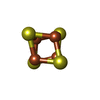+Search query
-Structure paper
| Title | The proofreading mechanism of the human leading-strand DNA polymerase ε holoenzyme. |
|---|---|
| Journal, issue, pages | Proc Natl Acad Sci U S A, Vol. 122, Issue 22, Page e2507232122, Year 2025 |
| Publish date | Jun 3, 2025 |
 Authors Authors | Feng Wang / Qing He / Michael E O'Donnell / Huilin Li /  |
| PubMed Abstract | The eukaryotic leading-strand DNA polymerase ε (Polε) is a dual-function enzyme with a proofreading 3'-5' exonuclease () site located 40 Å from the DNA synthesizing site. Errors in Polε ...The eukaryotic leading-strand DNA polymerase ε (Polε) is a dual-function enzyme with a proofreading 3'-5' exonuclease () site located 40 Å from the DNA synthesizing site. Errors in Polε proofreading can cause various mutations, including C-to-G transversions, the most prevalent mutation in cancers and genetic diseases. Polε interacts with all three subunits of the PCNA ring to assemble a functional holoenzyme. Despite previous studies on proofreading of several Pol's, how Polε-or any Pol complexed with its sliding clamp-proofreads a mismatch generated in situ has been unknown. We show here by cryo-EM that a template/primer DNA substrate with a preexisting mismatch cannot enter the site of Polε-PCNA holoenzyme, but a mismatch generated in situ in the site yields three bona fide proofreading intermediates of Polε-PCNA holoenzyme. These intermediates reveal how the mismatch is dislodged from the site, how the DNA unwinds six base pairs, and how the unpaired primer 3'-end is inserted into the site for cleavage. These results unexpectedly demonstrate that PCNA imposes strong steric constraints that extend unwinding and direct the trajectory of mismatched DNA and that this trajectory is dramatically different than for Polε in the absence of PCNA. These findings suggest a physiologically relevant proofreading mechanism for the human Polε holoenzyme. |
 External links External links |  Proc Natl Acad Sci U S A / Proc Natl Acad Sci U S A /  PubMed:40440070 PubMed:40440070 |
| Methods | EM (single particle) |
| Resolution | 3.11 - 3.88 Å |
| Structure data | EMDB-49299, PDB-9ne6: EMDB-49300, PDB-9ne7: EMDB-49301, PDB-9ne8: EMDB-49302, PDB-9ne9: EMDB-49303, PDB-9nea: |
| Chemicals |  ChemComp-SF4:  ChemComp-MG: |
| Source |
|
 Keywords Keywords | REPLICATION / DNA polymerase / exo / holoenzyme / DNA |
 Movie
Movie Controller
Controller Structure viewers
Structure viewers About Yorodumi Papers
About Yorodumi Papers













 homo sapiens (human)
homo sapiens (human)